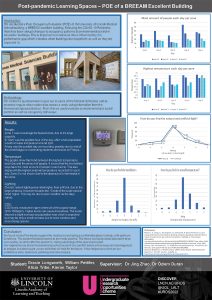By Gracie Longworth, William Pettifer, Kieran Taylor, Alicia Tribe (Lincoln School of Architecture and the Built Environment)
Supervisors: Dr Jing Zhao, Dr Özlem Duran
This project is a Post Occupancy Evaluation (POE) of the University of Lincoln Medical School building, a BREEAM excellent building that was completed in March 2021, a time when face-to-face teaching was making a gradual return following the lockdown caused by the COVID-19 Pandemic. The pandemic has led to abrupt changes to occupancy patterns & environmental control in education buildings. This is important to monitor as this is influenced by the performance gap which is when buildings do not perform well as they should do.
To investigate occupancy patterns, we produced a set of questionnaires to give to the medical school users which illustrate their satisfaction on the building services such as light, temperature & ventilation. To investigate environmental control, we used the thermostats in the building to record the buildings temperature & CO2 levels onto observation sheets. This was done across 5 zones in the building, 3 on the first floor & 2 on the second floor. Using the answers to the questionnaires & the recordings from the observation sheets, we were able to create graphs on Excel to show our results.
Our results show that due to its largest capacity, zone 1 was the busiest zone on average. 9-10 was the quietest hour of the day with a general peak in population at 2pm. Friday was the quietest day recorded, possibly due to commuting students who travel on Fridays or end of week fatigue. It was also shown that the two hottest days have the most amount of people in each zone. This also aligns with the highest external temperature recorded for each day. In terms of lighting, natural lighting was rated higher than artificial, due to the large windows, however towards the +3 side of the scale natural was rated higher. This may be due to poor weather as the days varied. CO2 levels, measured in ppm, were all within a good range, (400-1000ppm). Higher levels can cause drowsiness. The levels showed a slight decrease as population rose which is unusual but may be due to more windows and doors being opened.
Overall, the results have found that the building is a comfortable place to study with optimum conditions. Most of the students gave positive feedback. The number of people recorded have indicated that the building is well used following the COVID-19 pandemic.
This was a project that we found interesting, especially with getting to know the building, its uses & the users’ opinions. It also presented some challenges, as we found that the creation of the survey was quite hard as we had to anticipate which questions would help us to analyse the building & not ask too many. We also found asking strangers who were busy working a bit uncomfortable although this helped to boost our confidence skills. Another challenge was that towards the end of the week, we were less able to find people that had not yet filled out one of our surveys. What made it further challenging was that due to exams approaching at the time, there were people who were unwilling to participate due to their revision although this number was low. The analysis section of the project was something that we found very difficult as we had not used excel before or worked with large data sets. This meant that we had to learn as we went. Figuring out what would be useful to analyse was also something we found tricky.
In conclusion we found that as researchers for this project, we were pushed out of our comfort zones & we learned new skills such as using excel & helped us with our confidence skills, teamwork, planning & data analysis.
*To view the research poster for this project, please click on the thumbnail below:
